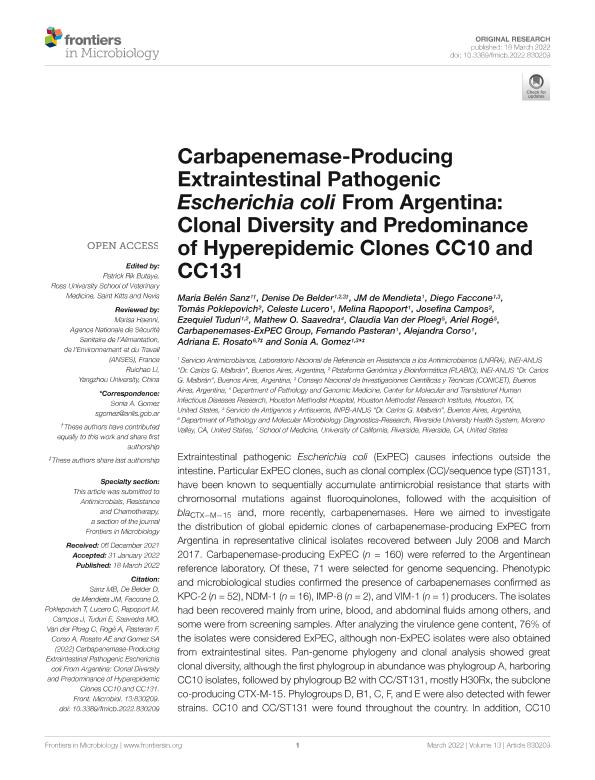Artículo
Carbapenemase-Producing Extraintestinal Pathogenic Escherichia coli From Argentina: Clonal Diversity and Predominance of Hyperepidemic Clones CC10 and CC131
Sanz, María Belén; de Belder, Denise Gisele ; de Mendieta, Juan Manuel; Faccone, Diego Francisco
; de Mendieta, Juan Manuel; Faccone, Diego Francisco ; Poklepovich, Tomás; Lucero, Celeste; Rapoport, Melina; Campos, Josefina; Tuduri, Ezequiel; Saavedra, Mathew O.; Van der Ploeg, Claudia; Rogé, Ariel Diego; Pasteran, Fernando; Corso, Alejandra; Rosato, Adriana E.; Gómez, Sonia Alejandra
; Poklepovich, Tomás; Lucero, Celeste; Rapoport, Melina; Campos, Josefina; Tuduri, Ezequiel; Saavedra, Mathew O.; Van der Ploeg, Claudia; Rogé, Ariel Diego; Pasteran, Fernando; Corso, Alejandra; Rosato, Adriana E.; Gómez, Sonia Alejandra
 ; de Mendieta, Juan Manuel; Faccone, Diego Francisco
; de Mendieta, Juan Manuel; Faccone, Diego Francisco ; Poklepovich, Tomás; Lucero, Celeste; Rapoport, Melina; Campos, Josefina; Tuduri, Ezequiel; Saavedra, Mathew O.; Van der Ploeg, Claudia; Rogé, Ariel Diego; Pasteran, Fernando; Corso, Alejandra; Rosato, Adriana E.; Gómez, Sonia Alejandra
; Poklepovich, Tomás; Lucero, Celeste; Rapoport, Melina; Campos, Josefina; Tuduri, Ezequiel; Saavedra, Mathew O.; Van der Ploeg, Claudia; Rogé, Ariel Diego; Pasteran, Fernando; Corso, Alejandra; Rosato, Adriana E.; Gómez, Sonia Alejandra
Fecha de publicación:
03/2022
Editorial:
Frontiers Media
Revista:
Frontiers in Microbiology
ISSN:
1664-302X
Idioma:
Inglés
Tipo de recurso:
Artículo publicado
Clasificación temática:
Resumen
Extraintestinal pathogenic Escherichia coli (ExPEC) causes infections outside the intestine. Particular ExPEC clones, such as clonal complex (CC)/sequence type (ST)131, have been known to sequentially accumulate antimicrobial resistance that starts with chromosomal mutations against fluoroquinolones, followed with the acquisition of blaCTX–M–15 and, more recently, carbapenemases. Here we aimed to investigate the distribution of global epidemic clones of carbapenemase-producing ExPEC from Argentina in representative clinical isolates recovered between July 2008 and March 2017. Carbapenemase-producing ExPEC (n = 160) were referred to the Argentinean reference laboratory. Of these, 71 were selected for genome sequencing. Phenotypic and microbiological studies confirmed the presence of carbapenemases confirmed as KPC-2 (n = 52), NDM-1 (n = 16), IMP-8 (n = 2), and VIM-1 (n = 1) producers. The isolates had been recovered mainly from urine, blood, and abdominal fluids among others, and some were from screening samples. After analyzing the virulence gene content, 76% of the isolates were considered ExPEC, although non-ExPEC isolates were also obtained from extraintestinal sites. Pan-genome phylogeny and clonal analysis showed great clonal diversity, although the first phylogroup in abundance was phylogroup A, harboring CC10 isolates, followed by phylogroup B2 with CC/ST131, mostly H30Rx, the subclone co-producing CTX-M-15. Phylogroups D, B1, C, F, and E were also detected with fewer strains. CC10 and CC/ST131 were found throughout the country. In addition, CC10 nucleated most metalloenzymes, such as NDM-1. Other relevant international clones were identified, such as CC/ST38, CC155, CC14/ST1193, and CC23. Two isolates co-produced KPC-2 and OXA-163 or OXA-439, a point mutation variant of OXA-163, and three isolates co-produced MCR-1 among other resistance genes. To conclude, in this work, we described the molecular epidemiology of carbapenemase-producing ExPEC in Argentina. Further studies are necessary to determine the plasmid families disseminating carbapenemases in ExPEC in this region.
Palabras clave:
CARBAPENEMASE
,
ESCHERICHIA COLI
,
EXPEC
,
HIGH RISK CLONE
,
PHYLOGENY
Archivos asociados
Licencia
Identificadores
Colecciones
Articulos(SEDE CENTRAL)
Articulos de SEDE CENTRAL
Articulos de SEDE CENTRAL
Citación
Sanz, María Belén; de Belder, Denise Gisele; de Mendieta, Juan Manuel; Faccone, Diego Francisco; Poklepovich, Tomás; et al.; Carbapenemase-Producing Extraintestinal Pathogenic Escherichia coli From Argentina: Clonal Diversity and Predominance of Hyperepidemic Clones CC10 and CC131; Frontiers Media; Frontiers in Microbiology; 13; 3-2022; 1-11
Compartir
Altmétricas



